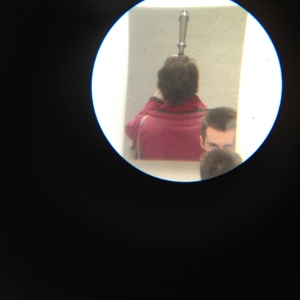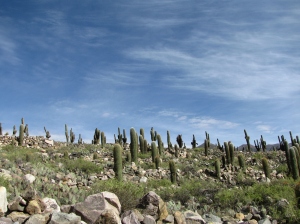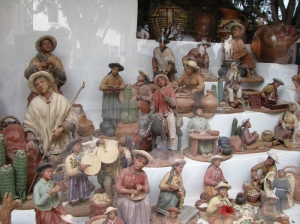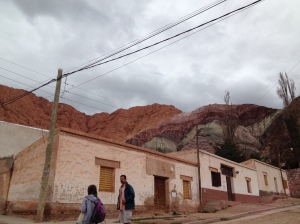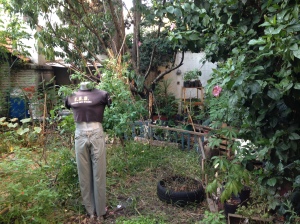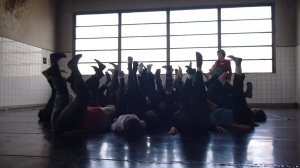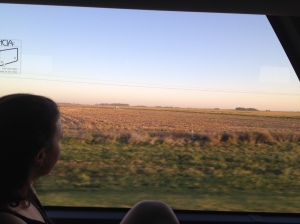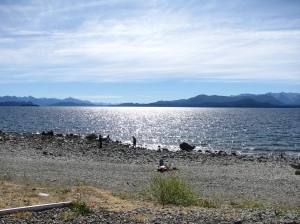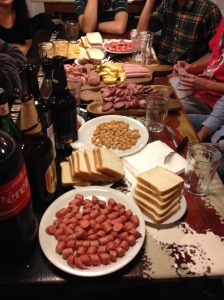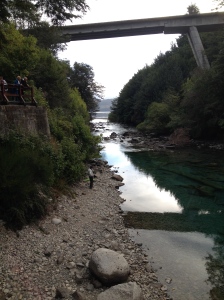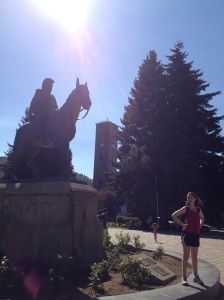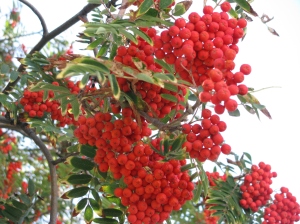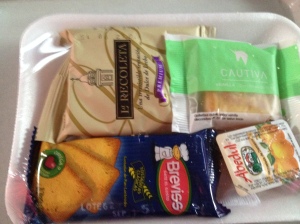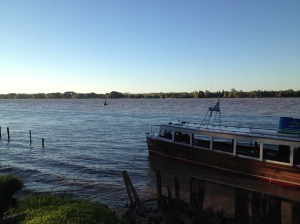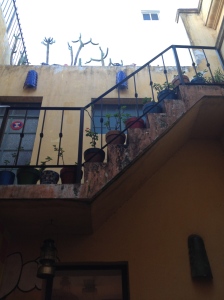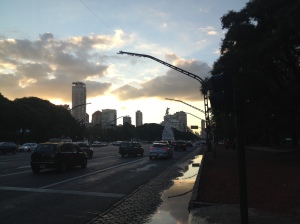I have yet to post information about my daily life. Perhaps to me, now a fully immersed city dweller with a routine and activities I enjoy and others I do out of obligation, the everyday stuff of life doesn’t seem fit for a blog that consists of the Most Exciting Memories of My Trip to A Foreign Land Called Argentina. What is writing, as an art and a means of communication, if not the act of unearthing the elements of daily ups and downs that merit mention? It’s not only the “what” of my stay in Buenos Aires that I hope to carry with me into the future and transmit to anyone reading these words, but “how” I approach each hour and the method of reflection that influences the next decision to be made determines how interesting, and blog-worthy, my life is. The decision-making is constant, in a city so pulsing with creative, opinionated, resourceful and social people who offer an incalculable number of interesting events to attend, especially given that as a non-working student I have the time to participate in such a rich cultural life. As I am taking five classes but only two for college “credit” (and beyond that, the pressure of grades nearly doesn’t exist given that I only need pass those two academic classes to count them toward my degree) I have given myself the option to demote academics from automatic first-priority down to being valued on equal footing with other opportunities to learn, grow, enjoy and be challenged by life. I am creating my own path, and in the process defining my interests and priorities on a day-by-day, sometimes minute-by-minute, basis. The internet plays an incredibly powerful role in this privileged yet complicated lifestyle, as it invites entrance into a virtual world with limitless access to information from every corner of the globe and the temptation to fantasize about my next step, whether it be the job(s) I dream about getting post-college, the courses I could take next semester, the concert I might attend next weekend or the museum or café I choose to visit today. This dreamworld of graphics, opinions, entertainment, and news opens its sexy pixelated arms to us all, tempting us away from the messy, imperfect real-time interactions that comprise our mysteriously taxing yet thrilling existence on the planet. The web can equal life, nowadays. It often seems we cannot escape it, no matter what it does to us psychologically. It is a vortex more powerful than any other stimulus, with the exception of love I think… But if we spend our lives in front of a screen, obsessing over what could be, decrying what was, and google searching the meaning of life, how will we find that love– whether it be platonic, romantic, academic, artistic, cultural, political, philosophical? Where will the real motivation and drive that propels us out of bed in the morning be found–simply in a pandora’s box of digital consumption? No. We need presence, both mental and physical, to endow our bodies and our minds with healthy energy and a zest for engaging with what is happening now, whether it be horrifying or poetic, beautiful or ugly. How will we know the difference if we do not allow ourselves to be vulnerable and available to the stimuli or willing to work with commitment for the sake of our passions despite the difficulties we may face or the questions that still linger in the air?
Enough musing…this all has to do with my study abroad experience, but as I know my audience, I’ll get down to the more “earthy” details (and the photos…as promised, mom….). I’ll go chronologically through a typical week and describe my activities.
On Mondays, I usually hop on my bike (in reality, it belongs to my lovely housemate Annie, who has returned to the US until August and has graciously lent me her chariot on two wheels) at around 9:30am and head south-east along the bike lanes of Villa Crespo, my neighborhood) toward Caballito, where I take a four-hour class called Historia Socio-Cultural del Arte at UNA, the Universidad de Nacional de las Artes, in their dance building. Each facultad, or “department” of the public universities is in a different part of the city. Attempting to complete simultaneous degrees in dance and environmental studies, for instance, would be a transit nightmare. Luckily, the public universities are free and allow students to complete (or not) a degree in any length of time. So, if you decide to become a doctor and realize mid-forties that you have a penchant for geography or playing the bassoon, you can work 9-5 and those 7-10pm classes once or twice a week will await, free of charge. Yes, there are middle-aged women dancing right along side the 18 year olds in my expresión corporal (modern dance meets physiology meets psychology meets theatrical movement) class at UNA. Because education is a human right, is it not? It is fundamental to a democratic society, is it not? Oh, U.S. academia, I scoff at your plush private campuses inaccessible to the vast majority of education-seeking Americans. Pff. Okay, back to describing MY my daily life…
For Historia Socio-Cultural del Arte, approximately 100 dancers crowd shoulder to shoulder into squeaky desks in a long, echoey rectangular room on the third floor of UNA between 10 and 10:20AM, because starting several minutes late is rarely shunned here in my experience. The mate gourds, bags of assorted fruits and packages of galletitas (anything ranging from a cardboard-like cracker to a straight-up cookie) emerge sporadically throughout the room in preparation for the sedentary Monday-morning marathon of left-brain usage ahead. If the professor is not projecting his or her (there are two teachers who oscillate class sessions) voice or doesn’t swivel like a lighthouse to convey the lecture to everyone in the room, the neglected section will often begin conversing or whip out their hand-held screens in immediate distraction. This doesn’t seem to phase the professor, who might dismissively “shh” the other side or continue lecturing without hesitation. The class traces the evolution of “art” (I place this is in scare quotes because the definition errs on the ambiguous or generalized side), largely within the Argentine, occasionally global, societal context. We discussed the interconnected spheres of art, myth and and rituals in ancient and indigenous Latin American societies as well as during the industrial revolution in Argentina, a country that made various efforts to promote a strong national identity on the international cultural and economic stages at the turn of the century. Buenos Aires, like New York, has a large (and ever growing) immigrant population due to its relatively lax open-door policy that ushered in an especially overwhelming quantity of people at the turn of the century (coming from literally all across the globe, however Argentina is known for its Italians, Jews, Armenians, French, Chinese and more recently Bolivians, Peruvians and Chileans and Paraguayans, whose cultural influences are apparent in the cuisine, vibrant artistic communities and ethnically defined neighborhoods of the city). Unifying a nation with such a diversity of communities without long ancestral ties to the fatherland required some magical myth construction and promotion of symbolic figures through primary education and public monuments. Writers such as Borges approached the disconnect between the life of the countryside (symbolized by the “gaucho,” or cowboy) and the rapidly expanding urban hub of Buenos Aires, whose middle to upper classes were craning their necks toward cosmopolitan cities in Europe and North America and whose working classes were struggling for political rights and a decent quality of life. With an eye toward Western Europe, Argentina built up its architectural profile in the styles of French, Italian, British, and Spanish traditions around the turn of the century in an attempt to solidify its “international” identity in the eyes of future tourists, investors and immigrants. Tango, and a strong (unfortunately often violent) culture of machismo blossomed in the red light districts of the city, as overwhelming populations of largely young male immigrants searched for romance and diversion from long idle days spent in search of steady work. Tango exploded as a full on cultural industry by the 1940s and 50s, inviting the efforts of composers, live musicians, the recording industry, dancers, nightclubs, filmmakers, actors and actresses…everyone type of performer could find something to express through this uniquely Buenos Aires genre that was born out of the melting pot of stylistic influences that invaded the city and the melodramatic existence of being an often impoverished, lovesick immigrant with a need to sing it, dance it, act it or simply listen it off.
Some tango circles now encourage gender-bending but the dance remains, in the vast majority of venues both touristy and strictly hospitable to locals, steeped in the male leader–female follower structure. Though the follower has opportunities in tango to express oneself and detain the leader with “adornments,” (sliding, bending, wrapping or simply protruding a leg around or to the side of the leader), the leader decides and communicates through corporal codes and impulses the sequence of steps and direction the couple will take together. I attended a progressive tango class with a friend I met in my expresión corporal class, in which we used balloons, strings, lack of eyesight or shoes to ease more intuitively into the process of bodily communication. The central challenge of tango, despite myriad step sequences to incorporate into a dancer’s vocabulary and the particulars of how to position each body, is learning to listen and share a moment of vulnerable yet controlled intimacy with your partner, who is often a complete stranger when one goes to a tango class or club (called a milonga). Maintaining your torso parallel to your partner is essential; when a leader pauses and there comes a time for a leg embellishment, it’s easy to lose this magnetic force between torsos; I personally tend to twist and turn, especially as a beginner attempting less than perfectly to read the signals I receive from my partner, which take the form of subtle increases of pressure on my scapula, widening or twisting of the embrace to indicate a change of direction, or deep inhales in preparation for an advance. Usually without eye contact, torsos and cheeks touching. Yes, it’s as sensual as it sounds. In this class, however, we were asked to communicate the same messages but as both leaders and followers who can transition wordlessly from one role to the other through pauses and impulses. Here, the game becomes more obviously linked to fundamental human challenges and pleasures: that of encountering another humbly yet boldly, striving to be both shrewd and direct, yet also tender and observant. For all you folks out there who associated tango with tacky dinner theaters, glitzy tight costumes and austere fedoras, or simply Astor Piazzolla (who is a genius, you should look him up right now if you’ve never heard him), welcome to the wonderfully complicated psycho-physical web of sensations that is the bare bones practice of tango. It’s the alluring mystery and perpetual sense of drama that addicts tango fanatics all over the world, carrying them from milonga to milonga, city to city, striving to improve their technique and ability to connect profoundly with strangers for three tensely beautiful minutes. I will not pretend to ignore the fierce machismo I’ve experienced with male dancer partners, not only in milongas but also while dancing salsa, bachata, swing, and even expresión corporal. I’ve gotten used to shrugging off anything from gag-worthy exaggerated compliments to patronizing remarks about my incorrect technique if they’re peeved that they got stuck with a beginner. The second I open my mouth is inevitably followed by a, “¿De dónde sos?” (“Where are you from?”) and, if this somehow signals that I a) will be more easily manipulated to accommodate their whims on or beyond the dance floor or b) represent an opportunity to practice their basic English and knowledge of American geography, I may unwittingly find myself answering a banal string of basic questions and/or deliberating between offering up my last name to another dude so he can friend me (and continuously message me) on Facebook. I have realized that such treatment may not be the norm and were I not an extranjera I would probably not be subject to most of it. Am I complaining? Maybe a little. It’s annoying to be treated as a naïve foreigner type (especially a woman who gives off unassuming, friendly vibes to most humans she encounters), an automatic representative of an entire country (that I currently have ridiculously mixed feelings about having been born into), and a body to be overtly judged or praised, unsolicited. I am empathizing, I imagine, with the vast majority of immigrants, refugees, passers through, or simply folks with features or qualities or identities that do not fit seamlessly into societal norms. I need not launch into a privilege rant, but the micro-aggressions and misogyny I’ve experienced as a white American girl living comfortably in the westernized, urban middle-class realm of Buenos Aires, is akin to feeling a pea poking your back through a stack of mattresses in comparison to the dire reasons we need intersectional feminist movements to fight domestic violence, racism, classism, all the isms….but it is useful to recognize the presence of machismo and xenophobia in my own fairly cushy and safe quotidian existence, both here and at home…
Well, it seems I only made it through a description of my first Monday class and a (hopefully interesting) digression. I pause, to focus on other things such as an oral presentation on public protests and the life of the street in Buenos Aires, and eventually sleep. The next frontier for this blog is more commentary on weekly activities, the climate of home-life, ideas on what’s to come during my time here, and musings about finding purpose as a transitory foreigner (through art, forming relationships, talking to people who’ve known you your whole life, volunteering, venturing out of one’s comfort zone, and simply observing). Oh, and I have a few words about what’s going on in the US right now. I hope also to share a few sentences about the value of productive and self-loving self-control, and why in life we need to cultivate a “just do it” attitude to avoid developing complacency, laziness and depression. Why is therapy so stigmatized in the US? Everyone and their mother sees (and/or IS) a therapist in Buenos Aires, and their rates of drug consumption for mental illness are way lower than in our prescription-drug-crazed society up north in the Privatized States of America. We’re so afraid to share what’s happening in our internal existences– more often than not caused by a combination of societal factors rather than stemming from personal weaknesses or intrinsic mental problems–that we’ve developed an uncountable variety of prescription drugs to magically realign the synapses in our brains instead of actively recognizing the circumstantial factors that prove inhospitable to a healthy, content lifestyle so that we can develop strategies to confront them ourselves. Home remedies, if you will. For instance, I’m finding that sending my thoughts into the ether, letting go of any anxiety that comes with others’ reading and potentially having opinions about my thoughts, is quite liberating, and therapeutic. The process of striving to be bilingual and knowing that one’s time in a South American city is finite before she has to return to a tiny intellectual and cultural hotbed in the middle of Ohio to finish her undergraduate degree prompts a host of complex thoughts to navigate—simply chatting with friends and family sometimes doesn’t cut it. So here, ether, enjoy my thoughts!
Hasta pronto!
Besos,
Rebecca
P.S. Pictures are worth a thousand words.

Image of “Ni Una Menos,” an enormous protest against sexualized violence in Argentina that erupted a few weeks ago. Planned to be a modest march, the entire downtown commercial district was blocked up by protesters male and female, young and old, human and animal (yes, the dogs came along too). It was inspiring, and also borderline dangerous, for streams of protesters were headed in opposite directions due to lack
of communication about the direction of traffic, creating extremely tight jams. I was detained on a single street corner for about a half an hour, but it was worth it. If nothing else, the march was evidence of the overwhelming demand for societal action and change to address rampant machismo, inequality and recent surge in femicides in this country. FYI: http://www.bbc.com/news/world-latin-america-33001990

Gallery hopping in Villa Crespo with my good pal Nolan, who I will have the pleasure of continuing to explore and make art with at Oberlin our senior year. He and our friend Susannah are organizing a map-themed art show about getting to know a foreign city, being disoriented and learning to navigate, forming relationships and defining this experience emotionally, spatially, and artistically. I’ll be contributing an interactive map project that incorporates audio recordings I’ve been accumulating of my own voice singing, ambient sounds and place-specific soundscapes that I felt I needed to document. This was the perfect excuse to compile them into something cohesive. If you’re reading this and currently in Buenos Aires, COME! Next Wednesday, 1 de julio, Juan B. Thorne 493, 21 hasta 23hrs. There will be FOOD and MUSIC and MAPS and lovely PEOPLE to meet.
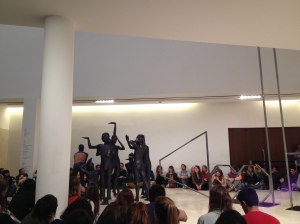
Performance art presentation at MALBA, interesting exploration of identity and movement and interaction with public spaces.
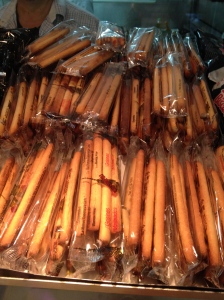
Spotted: breadsticks that are manufactured in the factory where I rehearse with my community dance group, being sold in a cafe in Recoleta. Small world. Glad their delishnessness is being spread all over the city. I will never think of breadsticks in the same way again. Any made by anoother company will forever be inferior, and any made by this company will remind me of the mountains of love that get manufactured by the bodies of Bailarines Toda la Vida every Friday at 6pm.
